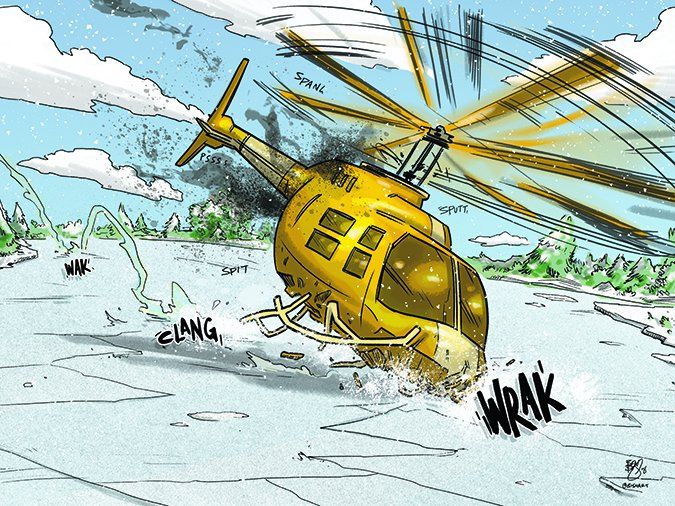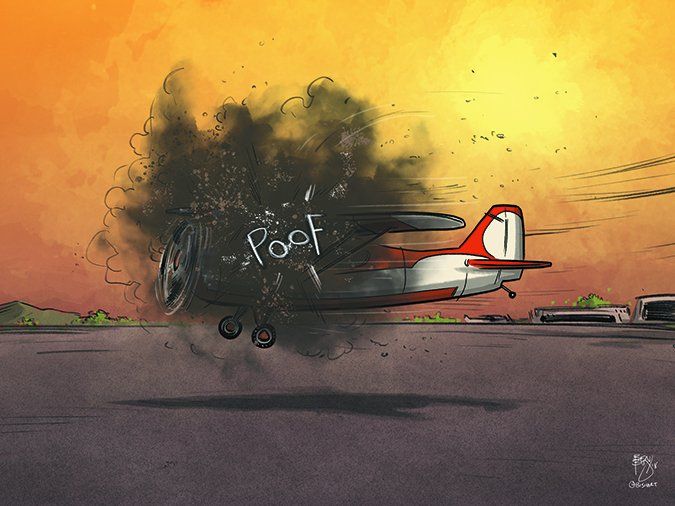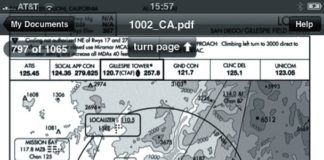Yep, it’s time to make fun of those who in 2015 ignored sound judgment and lived to garner pilot lounge derision. And, since pilots tend to repeat the same mistakes in hopes of different results, we heed George Orwell who said, “We have now sunk to a depth at which the restatement of the obvious is the first duty of intelligent men.” Since no intelligent man or woman stepped forward, it’s up to me.
Restating The Redundant
About 200 accidents annually are linked to carburetor icing. RPMs drop and the pilot thinks, “Huh, that’s odd,” as power degrades further, rendering carb heat useless. Other repeatable offenses include hot air balloons ejecting passengers on hard landings; ultralights flown by ultraidiots into ultraeverything, and gliders gliding not quite to the runway. Yet, fixed-wing pilots do the most crashing, often with stall/mush accidents in the traffic pattern, failing to recognize deteriorating airspeed or the warning sound of tree branches against gear legs (and that annoying horn). Many pilots assault the runway only to skedaddle into the weeds, dominating NTSB files with no cure in sight.
Ben Bishop
Too-cool tailwheel pilots get too aggressive on the brakes, digging spinners into the dirt, while helicopter pilots explore new ways to thrash tails and rotors into vehicles, wires, and antennas, too often with CFI presence if not guidance.
We salute their effort, but few were as conscientious as the Louisiana copter pilot who, after shutting down on an offshore platform, “secured the main rotor system by attaching a tiedown to the forward left main rotor blade and he then attached this tiedown to the left front skid cross tube.” Safe so far. He later started the engine and heard an “unusual noise.” Not so unusual when you consider the rotor was still tethered. Okay, show of hands: Have you tried to taxi your airplane without untying? Yeah, me too. It was like that only way more expensive.
In Alaska—a land rife with aviation challenge and folly—a Bell 206 pilot, for reasons unknown, flew the turbine helicopter from the left seat, when the book says the pilot “shall operate the helicopter from the right crew seat.” While in a hover above a frozen lake the lone pilot became distracted by the inconvenience of adjusting the rotor rpm linear actuator control switch, which is located on the right-seat collective control.
Picture the pilot taking his left hand off the left collective and moving it to the left cyclic. Then he had to “take his right hand off the left crew seat cyclic control and place it on the collective control for the right crew seat.” Remember how Scarecrow in The Wizard of Oz points his right hand to the left and his left to the right? Similar, only Scarecrow admitted he lacked a brain. The Bell smacked the ice hard enough to rupture the fuel cell, which the Scarecrow—er, pilot—didn’t realize, because he believed (“I do believe, I do believe…”) that “just the helicopter’s skids were damaged during the impact” and elected to fly home. Beliefs are swell, but reality drained all fuel from the ruptured cell, so the mangled Bell barely made it 50 feet before the engine quit, and, to his credit, the pilot made a fine emergency descent—from the left seat. Take that, Bell POH!
Ben Bishop
Fuel exhaustion, as in it’s too exhausting to figure the right fuel, is a perennial favorite. There was a Texas pilot whose mission—”Cantaloupe Bombing”—might have distracted him from checking fuel in his Cessna 206 before launching to bomb hostile melons back to the Stone Age. While turning onto the bomb run, the engine lost power, and the bomber pilot landed in mesquite trees behind enemy lines. Do cantaloupes take POWs?
Stupid bombing haunted a North Carolina pilot spreading ashes over a runway from his Aeronca Champ. Full disclosure: I’ve spread ashes from my Aeronca Champ, and, well, it went about the same. At 50 feet AGL on the 70-MPH ash-run, as the pilot/bombardier armed the ash ordnance for dispersal, the bag broke. Poof! To experience this, open a sack of fireplace ashes while driving down the Interstate with the left windows open and steering with your knees. Now, Dude, imagine doing it airborne. Confounded by the ghostly swirl of dead buddy ashes, the pilot “let go of the flight controls,” and the funereal Champ bounced, landed and skidded ash-backwards to a crumpled stop.
U Build It; U Load It; U Crash It
We admire those who build and fly their aircraft. Wright Brothers were on to something, but along the way a few homebuilders went wrong. Consider the Virginia pilot who landed a Zenair 750 on a turf runway with an eight-knot crosswind, ignoring crosswind correction, putting large sideloads on the gear causing an ignominious nose-flip onto the airplane’s back, dashing any hopes of Best In Show at Oshkosh.
Meanwhile in Kentucky, a proud builder pushed his Zenair 601 into the sunshine for its maiden flight. The airplane’s Corvair engine started just fine. Yes, Corvair, the air-cooled, 100-hp engine used in the 1960s Chevy Corvair dubbed by the world’s foremost buzz-killer, Ralph Nader, as “unsafe at any speed.” The pilot made a few practice runs and then sought the sky … as the little Zenair, renowned for its short-field capabilities, ate up 2500 feet of runway “or five times the distance of a nominal takeoff roll, before becoming airborne.” Hmm….
Our intrepid test pilot managed to coax self-delusion to 350 feet AGL, with the Corvair engine running just fine, thank you Mr. Nader, although spinning way too fast because the builder/test-pilot “had likely misread the propeller adjustment tool when installing and adjusting the pitch of the ground-adjustable propeller and had inadvertently set the blades to an extremely low pitch.” The result was like a politician’s promise—lots of noise but little thrust, a fact that should’ve been apparent, if not on runup but perhaps during the half-mile takeoff roll. Oh well. Try again tomorrow, Wilbur?
Another first flight went askew when a Virginia pilot applied power to his U-Fly-It ultralight only to discover that when U-Load-It with an aft CG, U-Crash-It.
Not to pick on the amateur built/flown crowd—it’s too easy—we present a commercial pilot transporting nine passengers in a Cessna Caravan to North Dakota. Everything went smoothly, until reaching the parking ramp when the pilot asked the passengers to please remain seated until the aircraft comes to a complete stop and falls on its ass. When the pilot exited the cabin to install the tail stand—like a sturdy broomstick to keep the tail from dropping—the already aft CG, suddenly without the pilot, slammed to the ground. Bong! The pilot then “reboarded and instructed the passengers to leave their seats and move forward, and the airplane righted itself.” Possibly the most fun anyone could have in North Dakota in November.
Stupid Mechanic Tricks
Behind every engine failure is a mechanic sweating a call from FSDO. This is our first year presenting the Mechanic-In-a-Supporting-Role awards. Earning bronze was an A&P who brought down a Cessna 170 in Washington. The pilot experienced loss of power while operating on the “Left” tank in climb, which purportedly had plenty of fuel. The right tank, not so much, so when silence ensued the pilot switched to “Both” tanks, expecting power. Nothing.
Investigators noted that fuel selector valve (FSV) worked properly, but the selector handle was installed 180 degrees off, meaning selecting Left accessed the right tank, while Right opened the left. Similarly, Off meant On and On was Off.
Cessna anticipated this possibility, so “the FSV handle had a hole drilled in it at manufacture that was angled to prevent incorrect orientation.” But no one anticipated our unknown mechanic drilling a new hole to install the handle bass-ackwards. The pilot who thought he was climbing on the fuller tank (left), was actually draining the lesser side (right). When the engine quit he switched to what he thought was On but had selected Bizarro World’s Off instead.
Another Washington mechanic threw in the towel for a UH-1 helicopter pilot. This was the second flight on the first day after “the engine had been replaced with an overhauled engine.” Post-accident sleuthing found that someone had “left a towel in the engine’s compressor section.” For simplicity of incompetence leading to substantial damage, this mechanic earns silver.
Our first ever Fool’s Gold Medal recipient is the mechanic who combined an inability to interpret simple directions with an inadvertent discovery of how pilots can drain their airplane’s oil in flight with the flick of a lever.
The Piper Arrow departed the California airport two days after a new oil quick drain was installed. Reaching 3500 feet MSL, the engine acted like it had no oil. It quit, and the pilot made a forced landing. Investigators later noted lots of oil on the airplane’s belly but little where it was needed. The new quick drain valve was the wrong part; when the nose gear retracted beneath the engine it opened the quick drain, thus quickly draining the oil. A Service Letter (SL) and an Airworthiness Directive (AD) warned that there were two types of quick-drain valves. “The SL provided a sketch of both the incorrect and correct oil quick drain valves and the AD provided the approved part number.” Any guess which one was installed? That’s why this mechanic takes home gold.
Radical Is As Radical Does
When going to a place named Hurricane, Utah, a pilot might be a little careful, expecting … well … wind. So, the Cirrus pilot who overshot the runway wisely went around for another try. After touchdown on the second attempt, the pilot reported a “radical right quartering tail wind that pushed the airplane to the left.”
Rather than remain safely on the ground, the pilot advanced the throttle and retracted half the flaps, attempting a go-around, or perhaps a touch-and-go. Either way, the Cirrus didn’t go beyond the omnipresent ditches that surround airports to catch runaway airplanes. The nearest weather reporting station reported radical winds at four knots.
Meet the Tennessee pilot who “decided that he wanted to practice landing with a tailwind.” Radical thinking but, heck, why not? Here’s why: The Skylane “touched down fast…” (Wow, really?) “…about 500 feet from the departure end of the runway, bounced a few times, and then overran the runway.” Perhaps after the airplane is rebuilt the pilot can practice partial-power takeoffs over obstacles or landings with his eyes closed.
And The Winners Are…
Selecting the best of the worst pilot indiscretions is difficult, like a New Jersey native selecting the worst pizza in Iowa, given so many choices. Still, one California Mooney pilot displayed enough persistent wrong stuff to get noticed.
“This was the airplane’s first flight after…” (fill in the blank). First flights after (fill in the blank) are too often the last—in this case, after a fresh paint job.
After starting the engine the pilot “observed a decrease in power” and leaned the mixture, until the engine “returned to normal idle speed.” During subsequent run-up the engine displayed a “delayed response.” Cold? Old avgas? Paint fumes? We, the NTSB, and the pilot don’t know, but engine issues seemed no reason to delay that critical first flight, especially since the “run-up otherwise revealed no anomalies.” Time to go; folks back home are waiting to see the new paint.
The takeoff roll “took longer than expected.” No reason to abort, so the shiny Mooney pressed on, “and after lifting off near the end of the runway, the airplane,” despite the fresh paint, “climbed more slowly than normal.” Granted, with new colors, crappy performance might now be normal. The pilot had little time to consider that as the power dropped to 1800 RPM, and the Mooney “could not maintain a climb.” Into the trees the Mooney plowed, but, protected by fresh urethane, the pilot was uninjured.
No anomalies were found during the investigation. Lessons: Always make the first flight the second flight, so it doesn’t warrant last rites. And if your pig-ugly airplane still flies as well as it did the day you two fell in love, forego the lipstick.
Our theme, if you wish to look for it, is the pilot community’s willingness to rehash the oldies, like hand-propping airplanes by pilots who should seriously consider public transit. Enter an Aero Commander 100 (like a Cessna 172 with a Mooney tail) in Texas with a dead battery. No problem. The pilot instructed the non-pilot passenger to remain in the right seat as he chocked the left main gear, and propped open the pilot’s side door. Can’t be too safe.
With a mighty heave on the prop, the engine started, and the airplane jumped the—one—chock and did what airplanes do with the throttle set a wee bit too high. It raced away with the pilot running alongside attempting to open the now shut door. You can mentally play the Yakkity Sax music.
The Commander quickly accelerated and the pilot couldn’t keep up. And that worthless passenger wasn’t any help, so the pilot—in command?—leapt upon the landing gear. Like Tom Cruise (or Jerry Lewis) hanging onto the lift strut, he attempted to claw his way into the cabin “while telling the passenger to pull the brake, throttle, mixture, or turn off the ignition key switch.” Stupid passenger just sat there feigning panic. Things went from silly to surreal when the airplane “impacted a 10-inch barrier, knocking the pilots legs off the main landing gear, and the airplane ran over the pilot’s leg.”
But our hero wouldn’t be discarded that easily. He hung onto the strut, desperately trying to get the passenger to open the door, “but the propwash was making this feat impossible.” The passenger experienced a first solo takeoff, and the pilot dropped from the strut to the ground. The airplane briefly climbed before nosing over and crashing into a dirt pile. Surprisingly, the pilot’s injuries were “minor,” while the passenger suffered “serious” injuries.
For the Commander pilot’s tenacious efforts to undo an ill-conceived decision to hand-prop one of the ugliest airplanes ever made, we award this year’s Stupid Pilot Tricks Grand Champion Flubbing Cup. But to those among us who’ve snickered in the self-assured notion that “I’d never do that,” perhaps we should first secure a mirror and contemplate advice from Okefenokee’s greatest philosopher, Pogo, who said, “We have met the enemy, and he is us.”
Paul Berge, past editor of IFR, flies his Champ, writes, instructs, and creates videos in Iowa. See his web page at PaulBerge.com.




